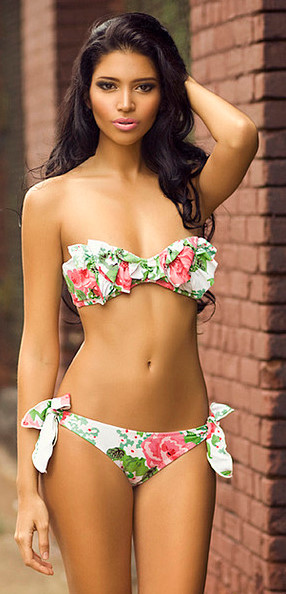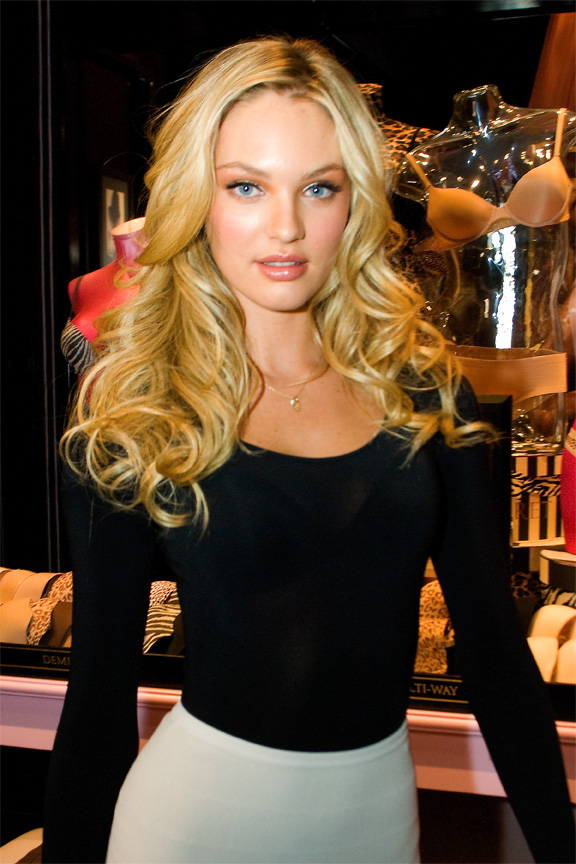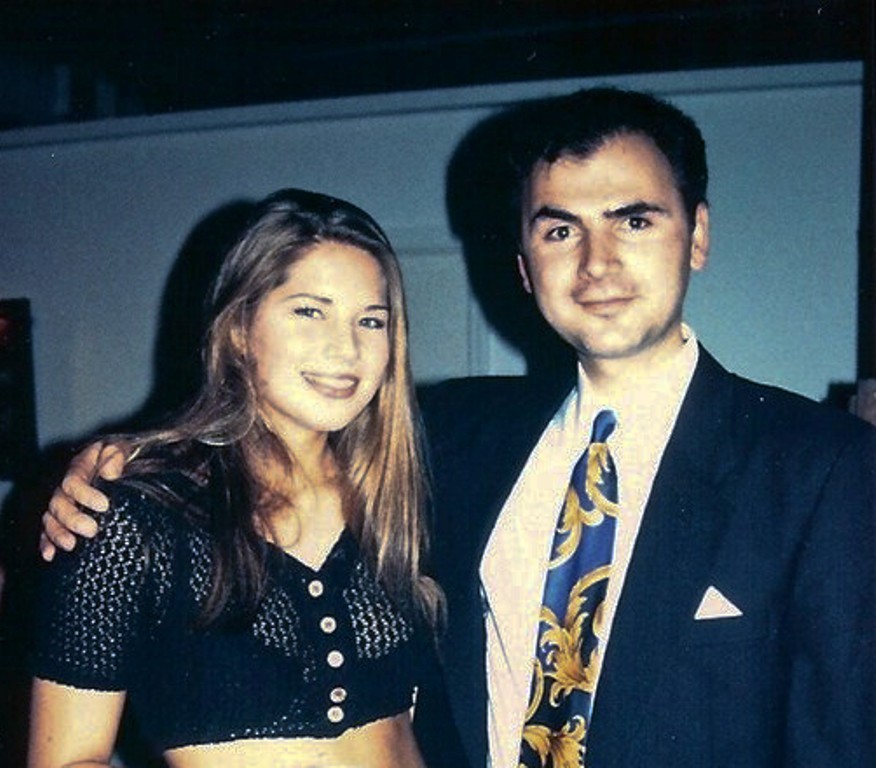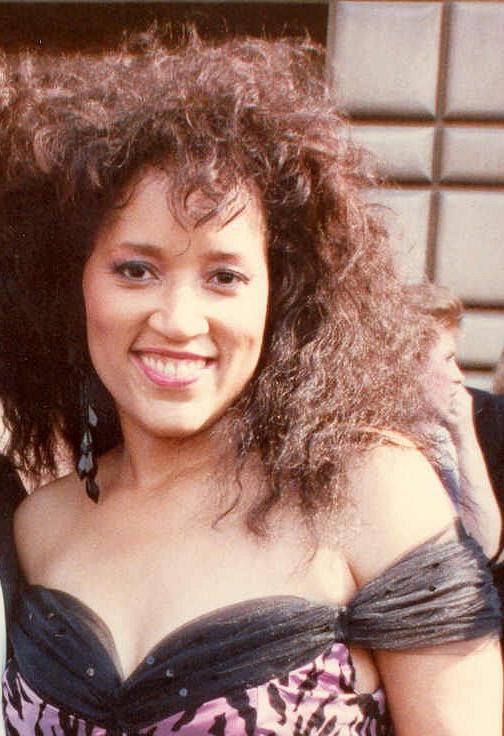|
Tube Top
A tube top, colloquially known in the UK as a boob tube, is a shoulderless, sleeveless women's garment that wraps around the upper torso. It is generally tight over the breasts, and usually uses elastic bands at its top and bottom to prevent it from falling. The tube top's precursor was a beachwear or informal summer garment worn by young girls in the 1950s that became more widely popular in the 1970s and returned to popularity in the 1990s and 2000s. In 2012, Iranian-Israeli fashion designer Elie Tahari claimed that he helped popularize the tube top after his arrival in New York in 1971. The original tube tops, as spotted by Tahari in a New York factory run by Murray Kleid, were elasticated gauze tubes reportedly produced through a factory manufacturing error. Murray ran with this product for years, and eventually Tahari bought tubes from Kleid, later setting up his own factory to mass produce tube tops to meet widespread demand. Dress code controversies In the 2010s, tube tops ... [...More Info...] [...Related Items...] OR: [Wikipedia] [Google] [Baidu] |
Woman Visitor At Kuala Lumpur Bird Park, Malaysia-10Aug2010
A woman is an adult female human. Prior to adulthood, a female human is referred to as a girl (a female child or Adolescence, adolescent). The plural ''women'' is sometimes used in certain phrases such as "women's rights" to denote female humans regardless of age. Typically, women inherit a pair of X chromosomes, one from each parent, and are capable of pregnancy and giving childbirth, birth from puberty until menopause. More generally, sex differentiation of the female fetus is governed by the lack of a present, or functioning, SRY-gene on either one of the respective sex chromosomes. Female anatomy is distinguished from male anatomy by the female reproductive system, which includes the ovaries, fallopian tubes, uterus, vagina, and vulva. A fully developed woman generally has a wider pelvis, broader hips, and larger breasts than an adult man. Women have significantly less facial and other body hair, have a higher body fat composition, and are on average shorter and less muscu ... [...More Info...] [...Related Items...] OR: [Wikipedia] [Google] [Baidu] |
Bandeau
A bandeau (pl. bandeaux, diminutive of french: bande meaning "strip") is a garment comprising, in appearance, a strip of cloth. Today, the term frequently refers to a garment that wraps around a woman's breasts. It is usually part of a bikini in sports or swimwear. It is similar to a tube top, but narrower. It is usually strapless, sleeveless, and off the shoulder. Bandeaux are commonly made from elastic material to stop them from slipping down, or are tied or pinned at the back or front. In the first half of the 20th century, a "bandeau" was a narrow band worn by women to bind the hair, or as part of a headdress. Used for headband from 1706, for brassiere from 1915. Contemporary uses Modern swimwear The bandeau emerged as the top part of a two-piece swimsuit during the 1940s. In the 1950s the bandeau incorporated foundation so as to structure the contours of the body, while still retaining a relatively simple circle or band shape, emphasizing the bare midriff. Another variatio ... [...More Info...] [...Related Items...] OR: [Wikipedia] [Google] [Baidu] |
Tops (clothing)
Tops or TOPS may refer to: Tops * Tops (band), a band from Montreal, Quebec * Tops Friendly Markets, an American supermarket chain * Tops Supermarket, a Thai supermarket chain * Tops Pizza, a British restaurant chain * "Tops", a Rolling Stones song on their album ''Tattoo You'' * Jan Tops (born 1961), a Dutch equestrian TOPS * TOPS, Total Operations Processing System, a railroad stock management system * TOPS (file server), a file-sharing system for the Macintosh and IBM PC *TOPS (Nortel), Traffic Operator Position System, a computer-based operator switchboard * TOPS Club, a non-profit weight-management organization in the United States * TOPS Program (Talented Offerings for Programs in the Sciences), a program at Marc Garneau Collegiate Institute, Toronto, Canada *TOPS-10, a Digital Equipment Corporation PDP-10 operating system *TOPS-20, a Digital Equipment Corporation PDP-10 operating system * Traffic Operations Practitioner Specialist, a non-professional certification for tran ... [...More Info...] [...Related Items...] OR: [Wikipedia] [Google] [Baidu] |
History Of Fashion
History of fashion design refers specifically to the development of the purpose and intention behind garments, shoes an accessories, and their design and construction. The modern industry, based around firms or fashion houses run by individual designers, started in the 19th century with Charles Frederick Worth who, beginning in 1858, was the first designer to have his label sewn into the garments he created. Fashion started when humans began wearing clothes. These clothes were typically made from plants, animal skins and bone. Before the mid-19th century the division between ''haute couture'' and ready-to-wear did not really exist. But the most basic pieces of female clothing were made-to-measure by dressmakers and seamstresses dealing directly with the client. Most often, clothing was patterned, sewn and tailored in the household. When storefronts appeared selling ready-to-wear clothing, this need was removed from the domestic workload. The design of these clothes became in ... [...More Info...] [...Related Items...] OR: [Wikipedia] [Google] [Baidu] |
1970s Fads And Trends
Year 197 ( CXCVII) was a common year starting on Saturday (link will display the full calendar) of the Julian calendar. At the time, it was known as the Year of the Consulship of Magius and Rufinus (or, less frequently, year 950 ''Ab urbe condita''). The denomination 197 for this year has been used since the early medieval period, when the Anno Domini calendar era became the prevalent method in Europe for naming years. Events By place Roman Empire * February 19 – Battle of Lugdunum: Emperor Septimius Severus defeats the self-proclaimed emperor Clodius Albinus at Lugdunum (modern Lyon). Albinus commits suicide; legionaries sack the town. * Septimius Severus returns to Rome and has about 30 of Albinus's supporters in the Senate executed. After his victory he declares himself the adopted son of the late Marcus Aurelius. * Septimius Severus forms new naval units, manning all the triremes in Italy with heavily armed troops for war in the East. His soldiers embark on ... [...More Info...] [...Related Items...] OR: [Wikipedia] [Google] [Baidu] |
2010s Fashion
The 2010s were defined by hipster fashion, athleisure, a revival of austerity-era period pieces and alternative fashions, swag-inspired outfits, 1980s-style neon streetwear, and unisex 1990s-style elements influenced by grunge and skater fashions. The later years of the decade witnessed the growing importance in the western world of social media influencers paid to promote fast fashion brands on Pinterest and Instagram. Popular global fashion brands of the decade included Abercrombie and Fitch, Adidas, Balenciaga, Ben Sherman, Burberry, Christian Dior, Coach, DSquared2, Dorothy Perkins, Fashion Nova, Forever 21, Gucci, H&M, Hollister, Hugo Boss, Lacoste, Louis Vuitton, Marks and Spencer, Michael Kors, Monsoon Accessorize, Nike, Nine West, Off-White, River Island, Supreme, Topman, Topshop, Uniqlo, Under Armour, and Vans. Designers and models The leading European and American designers of the early 2010s included Nicolas Ghesquière, Miuccia Prada, Frida Giannini, Ma ... [...More Info...] [...Related Items...] OR: [Wikipedia] [Google] [Baidu] |
2000s Fashion
2000s fashion is often described as being a global mash up, where trends saw the fusion of vintage styles, global and ethnic clothing (e.g. boho), as well as the fashions of numerous music-based subcultures. Hip-hop fashion generally was the most popular among young people of all sexes, followed by the retro inspired indie look later in the decade. Those usually age 25 and older adopted a dressy casual style which was popular throughout the decade. Globalization also influenced the decade's clothing trends, with the incorporation of Middle Eastern and Asian dress into mainstream European, American and Australasian fashion. Furthermore, eco-friendly and ethical clothing, such as recycled fashions and fake fur, were prominent in the decade. In the early 2000s, many mid and late 1990s fashions remained fashionable around the globe, while simultaneously introducing newer trends. The later years of the decade saw a large-scale revival of clothing designs primarily from the 1960s ... [...More Info...] [...Related Items...] OR: [Wikipedia] [Google] [Baidu] |
1990s Fashion
Fashion in the 1990s was defined by a return to minimalist fashion, in contrast to the more elaborate and flashy trends of the 1980s. One notable shift was the mainstream adoption of tattoos, body piercings aside from ear piercing and, to a much lesser extent, other forms of body modification such as branding. In the early 1990s, several late 1980s fashions remained very stylish among both sexes. However, the popularity of grunge and alternative rock music helped bring the simple, unkempt grunge look to the mainstream by 1994. The anti-conformist approach to fashion led to the popularization of the casual chic look that included T-shirts, jeans, hoodies, and sneakers, a trend which continued into the 2000s. Additionally, fashion trends throughout the decade recycled styles from previous decades, notably the 1950s, 1960s and 1970s. Due to increased availability of the Internet and satellite television outside the United States, plus the reduction of import tariffs under NA ... [...More Info...] [...Related Items...] OR: [Wikipedia] [Google] [Baidu] |
1980s Fashion
Fashion of the 1980s was characterized by a rejection of 1970s fashion. Punk fashion began as a reaction against both the hippie movement of the past decades and the materialist values of the current decade. The first half of the decade was relatively tame in comparison to the second half, which was when apparel became very bright and vivid in appearance. Hair in the 1980s was typically big, curly, bouffant and heavily styled. Television shows such as ''Dynasty'' helped popularize the high volume bouffant and glamorous image associated with it. Women in the 1980s wore bright, heavy makeup. Everyday fashion in the 1980s consisted of light-colored lips, dark and thick eyelashes, and pink or red rouge (otherwise known as blush). Some of the top fashion models of the 1980s were Brooke Shields, Christie Brinkley, Gia Carangi, Joan Severance, Kim Alexis, Carol Alt, Yasmin Le Bon, Renée Simonsen, Kelly Emberg, Inès de La Fressange, Tatjana Patitz, Elle Macpherson, and ... [...More Info...] [...Related Items...] OR: [Wikipedia] [Google] [Baidu] |
1970s Fashion
Fashion in the 1970s was about individuality. In the early 1970s, ''Vogue'' proclaimed "There are no rules in the fashion game now" due to overproduction flooding the market with cheap synthetic clothing. Common items included mini skirts, bell-bottoms popularized by hippies, vintage clothing from the 1950s and earlier, and the androgynous glam rock and disco styles that introduced platform shoes, bright colors, glitter, and satin. New technologies brought advances in production through mass production, higher efficiency, generating higher standards and uniformity. Generally the most famous silhouette of the mid and late 1970s for both genders was that of tight on top and loose on bottom. The 1970s also saw the birth of the indifferent, anti-conformist casual chic approach to fashion, which consisted of sweaters, T-shirts, jeans and sneakers. The French designer Yves Saint Laurent and the American designer Halston both observed and embraced the changes that were happeni ... [...More Info...] [...Related Items...] OR: [Wikipedia] [Google] [Baidu] |
Strapless Dress
A strapless dress or top is a garment that stays put around the upper body without shoulder straps or other visible means of support. It is usually supported by an internal corset and/or brassiere, with the tightness of the bodice preventing the dress from slipping out of position. History 1930s to 1980s According to Richard Martin and Harold Koda, the modern strapless dress first appeared in the 1930s, where it was popularised by designers such as Mainbocher and from the late 1940s, Christian Dior. The July 18, 1938, issue of ''Life'' claimed that the "absolutely strapless, sleeveless evening dress" was a 1937–38 invention. However, that was predated in 1930 by the actress Libby Holman, who had been photographed in an apparently strapless dress that year. Holman became associated with the strapless dress and is regularly credited with inventing it, or at least being one of its first high-profile wearers. In 1934, Mainbocher produced his first strapless gown, a black satin de ... [...More Info...] [...Related Items...] OR: [Wikipedia] [Google] [Baidu] |
National Organization For Women
The National Organization for Women (NOW) is an American feminist organization. Founded in 1966, it is legally a 501(c)(4) social welfare organization. The organization consists of 550 chapters in all 50 U.S. states and in Washington, D.C. It is the largest feminist organization in the United States with around 500,000 members. NOW is regarded as one of the main liberal feminist organizations in the US, and primarily lobbies for gender equality within the existing political system. NOW campaigns for constitutional equality, economic justice, reproductive rights, LGBTQIA+ rights and racial justice, and against violence against women. History Background There were many influences contributing to the rise of NOW. Such influences included the President's Commission on the Status of Women, Betty Friedan's 1963 book '' The Feminine Mystique'', and the passage and lack of enforcement of the Civil Rights Act of 1964 (prohibiting sexual discrimination). The President's Commission ... [...More Info...] [...Related Items...] OR: [Wikipedia] [Google] [Baidu] |

.jpg)



.jpg)




